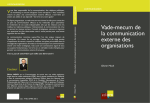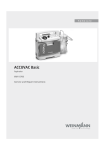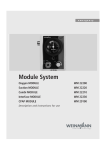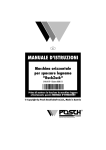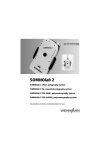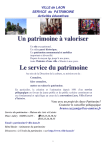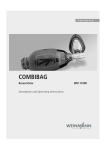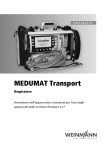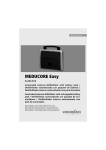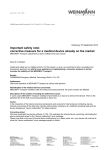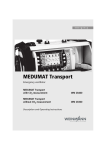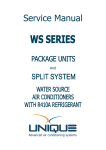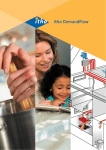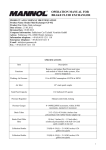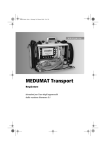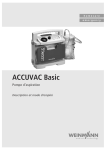Download WEINMANN Medumat Easy Ventilator Service Manual
Transcript
MEDUMAT Easy Ventilator Servicing and repair instructions WM 28000 Contents Introduction . . . . . . . . . . . . . . . . . . . . . . . . . . 3 1. Overview . . . . . . . . . . . . . . . . . . . . . . . . . . . 4 1.1 Special symbols on the ventilator . . . . . . 5 2. Description . . . . . . . . . . . . . . . . . . . . . . . . . . 2.1 Uses. . . . . . . . . . . . . . . . . . . . . . . . . 2.2 Ventilation function . . . . . . . . . . . . . . . 2.3 Demandflow function . . . . . . . . . . . . . . 2.4 Patient valve . . . . . . . . . . . . . . . . . . . 2.5 Audio response . . . . . . . . . . . . . . . . . 6 6 6 7 7 7 3. Final check . . . . . . . . . . . . . . . . . . . . . . . . . . 8 3.1 Testing equipment required . . . . . . . . . . 8 3.2 Preparing for final check . . . . . . . . . . . 8 3.3 Entering the device data . . . . . . . . . . . 8 3.4 Testing for leaks and pressure reading . . 9 3.5 Self-test when device is switched on . . . . 9 3.6 Functional check on controls (button check). . . . . . . . . . . . . . . . . . . 9 3.7 Functional test and alarms . . . . . . . . . 10 3.8 Battery power . . . . . . . . . . . . . . . . . 10 3.9 Test pressure sensors . . . . . . . . . . . . . 11 3.10 Functional check on frequency setting . . 12 3.11 Functional check breath volume at 4.5 bar input pressure and 10 mbar back pressure . . . . . . . . . . . 12 3.12 Checking O2 concentration . . . . . . . . 13 3.13 Functional check on pressure limit . . . . 13 3.14 Functional check on relief valve without patient valve . . . . . . . . . . . . . 13 3.15 Checking the type plate data . . . . . . . 13 3.16 Check on external condition . . . . . . . . 14 3.17 Documentation . . . . . . . . . . . . . . . . . 14 4. Servicing . . . . . . . . . . . . . . . . . . . . . . . . . . . 15 4.1 Intervals and scope . . . . . . . . . . . . . . 15 4.2 Batteries . . . . . . . . . . . . . . . . . . . . . 16 4.3 Storage . . . . . . . . . . . . . . . . . . . . . 16 5. Troubleshooting . . . . . . . . . . . . . . . . . . . . . . 17 6. Repair information and instructions . . . . . . . 20 6.1 General . . . . . . . . . . . . . . . . . . . . . 20 6.2 Changing the filter in the pressurised gas connection . . . . . . . . . . . . . . . . 20 6.3 Opening the device . . . . . . . . . . . . . 21 6.4 Closing the device . . . . . . . . . . . . . . 22 6.5 Replacing button cell . . . . . . . . . . . . . 24 6.6 Changing the speaker . . . . . . . . . . . . 25 6.7 Changing the board . . . . . . . . . . . . 26 6.8 Replacing the pneumatic block . . . . . . 27 6.9 Replacing the 3/2-way magnetic valve 29 6.10 Calibrating the potentiometer (after changing pneumatic block including potentiometer) . . . . . . . . . . . 30 6.11 Changing upper part of housing . . . . . 31 6.12 Changing the fascia film . . . . . . . . . . 32 6.13 Changing lower part of housing . . . . . 33 7. Spare parts . . . . . . . . . . . . . . . . . . . . . . . . . 35 7.1 Spare parts list . . . . . . . . . . . . . . . . . 35 7.2 Service sets . . . . . . . . . . . . . . . . . . . 37 8. Tools and Test Equipment . . . . . . . . . . . . . . . 38 8.1 General tools . . . . . . . . . . . . . . . . . . 38 8.2 Special tools . . . . . . . . . . . . . . . . . . 38 8.3 Testing equipment. . . . . . . . . . . . . . . 39 9. Technical data . . . . . . . . . . . . . . . . . . . . . . . 40 9.1 Pneumatic / electronic systems . . . . . . 41 10. Technical Changes . . . . . . . . . . . . . . . . . . . 42 11. Repair and service records . . . . . . . . . . . . . . 43 © Copyright WEINMANN GmbH & Co. KG. The content and presentation are copyright protected and may only be used by authorised WEINMANN Service Partners in the course of their service operations. The content must not be reproduced or passed on to third parties. The complete documents must be returned on termination of the cooperation with WEINMANN. 2 Introduction For decades WEINMANN has been developing, manufacturing and marketing devices for emergency medical care, oxygen therapy and inhalation therapy. In 1972 WEINMANN put the first MEDUMAT emergency respirator on the market. MEDUMAT emergency respirators are automatic respirators. They are used for controlled respiration in emergency medical care, e.g. in cases of acute respiratory disorders, and also secondary obstructions. The new generation of devices, developed specifically to meet users’ requirements and put on the market in 1997, offers users and patients increased security. An intelligent alarm system monitors the patient’s breathing and informs the user about any problems that occur. These devices thus offer even greater security and reliability during respiration. The aim of these servicing and repair instructions is to familiarise you, as an expert in the field, with the function, technology, servicing and repair of the MEDUMAT respirator. Thanks to training which you have already received from WEINMANN, you now count as “trained expert personnel” and can therefore give your customers appropriate instructions, remedy problems on your own and perform the functional checks prescribed in the operating instructions and any repairs required in accordance with these Service and Repair Instructions. In the event of a warranty claim, send the MEDUMAT to WEINMANN. To enable us to process ex gratia requests or warranty claims, please enclose the customer’s proof of purchase (invoice) with the device. Repairs or servicing work may be performed only by WEINMANN or by trained specialist staff. You are responsible for repairs carried out yourself and for their warranty! Use only original WEINMANN spares for repairs. Please bear in mind: Your customer trusts you and relies on your expert capability, just as you rely on WEINMANN. Note: For the following information, please consult the Operating Instructions for MEDUMAT: • Safety Information • Fitting accessories • Operating MEDUMAT emergency respirators • Hygienic preparation • Functional check Introduction 3 1. Overview Control panel MEDUMAT Easy 2 Respiratory pressure indicator (bar graph) 3 Alarm panel MEDUMAT Easy 60 mbar Stenosis Disconnection < 2,7 bar O2 50 4 Alarm confirmation 40 5 Colour code 30 20 10 0 11 12 9 10 10 14 12 13 7 11 6 Adjuster knob, ventilation parameters 14 16 16 5 15 7 Index position Demandflow 30 8 LED Demandflow 3 Freq.(min-1) MV (l/min) 1 Mask/tube ventilation switch with indicator LEDs 9 ON/OFF switch Connections MEDUMAT Easy AT MEDUM Easy 10 Pressurized gas connection 60 Stenosis ction ne Discon r O2 < 2,7 ba mbar 50 40 30 20 10 0 11 12 10 12 9 10 7 11 14 15 13 14 16 16 5 MEDU Easy Demand flow 30 60 MAT is Stenos tion nec Discon O2 < 2,7 bar mbar 11 Battery compartment 50 n-1) mi 3 Freq.( 40 in) MV (l/m 30 20 11 12 10 0 10 12 9 10 7 11 14 15 13 14 16 Demand flow 16 5 12 Speaker 30 in-1) 3 Freq.(m in) MV (l/m 13 Pressure gauge hose connection 14 Ventilation hose connection 15 Relief outlet valve 4 Overview 1.1 Special symbols on the ventilator Symbols on MEDUMAT Easy MAT MEDU Easy 60 te n hau Pressio basse n Pressio bar O2 mbar Typ : < 2,7 50 Typ : 40 30 20 11 12 10 0 MAT MEDU Easy 60 10 14 15 13 14 16 16 is Stenos tion nec Discon O2 < 2,7 bar mbar 10 12 9 7 11 5 30 3 50 40 30 20 11 12 10 0 10 12 9 10 7 11 14 15 13 14 16 Demand flow 16 5 30 3 Freq.(m MV in-1) (l/min) Inlet 2,7 - 6 bar O2. MEDUMAT Easy device information plate SN Serial number of device Year of manufacture Do not dispose of device in domestic waste. Safety check and servicing label Servicing label: indicates when the next service is due. Safety check label: (in Germany only) marks when the next safety check as per §6 of the German law relating to users of medical devices is required. Overview 5 2. Description 2.1 Uses MEDUMAT Easy is an automatic oxygen respiration device (short-term ventilator) with additional inhalation facility. You can use MEDUMAT Easy: • in emergencies; • to revive patients at the site of the emergency; • • for longer periods in more protracted emergencies, e.g. fires; when transport over considerable distances is planned. MEDUMAT Easy: • for short-term O2 inhalation using a respiration mask. You can use MEDUMAT Easy while transporting patients: • between the various rooms and departments of a hospital; • between the hospital and other premises; • is designed to provide controlled ventilation to persons of 10 kg body weight or more; • is used to treat respiratory arrest; • can be preset to parameters that ensure evenly balanced ventilation, provided that the selected maximum ventilation pressure Pmax is not exceeded; • permits breathing-controlled oxygen inhalation in Demand mode. 2.2 Ventilation function MEDUMAT Easy operates within a pressure range of 2.7 to 6 bar and at a flow rate of not less than 70 l/min O2. It has a built-in power supply. It uses high-pressure, medicinal-grade oxygen. An external pressure reducer brings this down to the required operating pressure. The oxygen supply is fed in at input valve 10. AT MEDUM Easy 10 60 Stenosis ion ect Disconn r O2 < 2,7 ba mbar 50 40 30 20 10 0 11 12 10 12 9 10 7 11 The ventilation settings are continuously variable. These settings (frequency and volume per minute are coupled) and the inspiration/expiration ratio of 1:1.67 are regulated by internal electronic control mechanisms. The gas for inspiration flows along the hose and through the patient valve and either the mask or tube into the patient’s airways. The patient valve is fitted with a lip membrane that enables expired gas to be conducted away through the expiration tube. 6 Description 14 15 13 14 16 - Demand flow 16 5 30 n-1) mi 3 Freq.( in) MV (l/m You can check the course of ventilation on the respiration pressure indicator 2. 60 mbar 50 40 2 30 20 10 9 0 2.3 Demandflow function The Demandflow setting switches the MEDUMAT Easy to breathing-controlled O2 inhalation. Such inhalation must be carried out with the respiration mask. A small inspiration (trigger) pulse causes oxygen to continue flowing until slight overpressure interrupts the flow. Expiration then takes place via the patient valve as in ventilation. Demandflow setting 10 11 12 9 0 10 10 13 7 11 5 14 12 15 14 16 16 Demandflow 30 3 Freq.(min-1) MV (l/min) 2.4 Patient valve The gas for inspiration is channelled into the patient’s airways through the patient valve. 38 The valve is designed to enable spontaneous breathing in the event of failure of the MEDUMAT Easy. 37 39 40 34 35 36 41 2.5 Audio response The device has an audio response facility that can be switched on for user guidance, especially for users who have little practice. If audio guidance is not wanted, it can be switched off by pressing a combination of keys (see “4.10 Audio response for user guidance” in the operating instructions). Description 7 3. Final check After every repair and every service, the device must be subjected to the following final check in accordance with Test Instructions WM 28001 and the test record. Note: For the final check on the MEDUMAT Easy you must connect the ventilation hose and the patient valve to the device. We recommend that you always hold reserve stocks of the following items: • replacement washers for the connections; • lip membrane for the patient valve. • membrane for spontaneous breathing tube; • membrane for exhalation tube; • O-ring 1145/118. MEDUMAT Easy must not be used if the final check reveals defects or deviations from the specified parameters. 3.1 Testing equipment required • Volume flow meter, Type RT 200 (Timeter), Type EKU VIP – ventilator, PF 300 Imtmedical or comparable test device • Adjustable orifice, e.g. ball valve, internal diameter ≥ 10 mm • Test set for functional checks WM 15323 • Oxygen concentration meter, 0 – 100% ± 1%, e.g. Type Oxycontrol WM 13550 • Set, hose with syringe WM 15359 • Pressure gauge 0 - 6.3 bar, class 1.6 • Pressure gauge 0 -100 mbar, class 1.6 • Set, supply test Medumat / Modules WM 15440 3.2 Preparing for final check 1. Connect MEDUMAT Easy to the 4.5 - 6 bar pressure supply. 2. Connect ventilation hose and pressure measurement tube to MEDUMAT Easy. 3. Device setting: Freq. = 30 min-1, MV = 3 l/min. 4. Language setting “English”. 3.3 Entering the device data • 8 Enter the device number and the tester number in the test record. Final check 3.4 Testing for leaks and pressure reading 3.4.1 Checking input side for leaks • With the device switched off, apply 6 bar pressure to input side and and shut off output pressure. Requirement: The pressure drop must be less than 0.2 bar/min. 3.4.2 Checking pressure measurement zone for leaks • Apply 55 mbar ± 2 mbar to MEDUMAT pressure measurement zone. MAT MEDU Easy 60 Requirement: The pressure drop must be is Stenos tion nec Discon bar O2 mbar < 2,7 50 40 ≤ 2 mbar/min. Test pressure gauge 30 20 11 12 10 0 10 12 9 10 7 11 14 15 13 14 16 16 5 30 3 13 Respiration pressure indicator Syringe 3.5 Self-test when device is switched on If audio response is enabled, you will hear the sentence “Open oxygen cylinder” before the self-test starts. 1. Apply 4.5 bar to the input. 2. Switch on MEDUMAT Easy at button 9. Requirement: The self-test starts, the ventilation mode LEDs light up once each one after the other, the alarm LEDs flash, the pressure indicator LEDs are run through 3 times, a signal tone sounds and an audio response sentence is spoken. 3.6 Functional check on controls (button check) 1. Open the pressure supply. 2. Switch on the device. 3. Switch from mask ventilation to tube ventilation. 4. Press the alarm acknowledgement button. Final check 9 3.7 Functional test and alarms 3.7.1 Test Stenosis alarm • Switch to tube ventilation ( ) and close patient valve outlet. • Operate device at Freq. setting = 30 min-1 and MV = 3 l/min. Requirement: The Stenosis alarm must be triggered after two ventilation cycles. If audio response is enabled, the ventilator announces “Check airways and minute volume”. 3.7.2 Checking alarm confirmation • Immediately after the first alarm tone sounds, press Alarm confirmation button 4. Requirement: The alarm tone must be suppressed immediately. 3.7.3 Test Disconnection alarm • Open patient valve outlet. Requirement: The Disconnection alarm must be triggered after two ventilation cycles. If audio response is enabled, the ventilator announces “Check ventilation system and settings”. 3.7.4 Test Pressure alarm • Shut off pressurised gas connection of MEDUMAT (2.7 - 6.0 bar). Requirement: The Pressure alarm must be triggered. If audio response is enabled, the ventilator announces “Check pressure hose system and gas supply”. 3.7.5 Checking Demand mode LED • Open the pressure supply. Requirement: Demand mode LED must come on (flickering). 3.7.6 Check voice output 3.8 Battery power 3.8.1 3.0 V battery (on board) Since the 3.0 V lithium cell is difficult to access, its charge status can be checked both via the interface and in a relevant menu. Bar graph value (mbar) Battery voltage (V) 60 3.21 55 3.19 To do so, hold down the alarm confirmation button while switching the device on. The device is then in battery check mode for 3 seconds, before switching to normal operating mode. 50 3.17 45 3.15 40 3.13 35 3.11 During this 3-second period the “Power supply” alarm in the alarm panel lights up and the voltage measured for the lithium cell is shown on the pressure bar graph. 30 3.09 25 3.07 20 3.05 15 3.03 The adjacent table shows how the voltage readings correspond to the bar graph values. 10 3.01 5 2.99 0 2.97 10 Final check Requirement: Voltage measured for 3.0 V battery is in the range 3.0 to 3.2 V; the alarm for this cell is triggered at 2.7 V. 3.8.2 3.6 V battery (battery compartment) Remove the 3.6 V battery from the battery compartment and measure the voltage with a digital multimeter. Requirement: Voltage measured for 3.6 V battery is in the range 3.4 to 3.7 V. 3.9 Test pressure sensors 3.9.1 Input pressure sensor • Shut off pressurised gas connection of MEDUMAT (2.7 - 6.0 bar). Requirement: The Pressure alarm must be triggered. If audio response is enabled, the ventilator announces “Check pressure hose system and gas supply”. 3.9.2 Ventilation pressure sensor • Connect ventilation hose to test bag. • Run device with settings: Freq. = 10 min-1 and MV = 11 l/min. • Switch device to mask ventilation. Requirement: The pressure limit must respond at 20 ± 5 mbar. • Switch device to tube ventilation. Requirement: The pressure limit must respond at 45 ± 5 mbar. 3.9.3 Demand flow sensor 1. Supply device with pressure. 2. Switch on MEDUMAT Easy at button 9. 3. Connect ventilation tube and patient valve to test bag. 4. Set MEDUMAT Easy to demand flow mode. 5. Green LED in demand mode button illuminates. 6. Squeeze the test bag. Requirement: Releasing the test bag triggers a short ventilation. Final check 11 3.10 Functional check on frequency setting MAT MEDU Easy osis Sten ection Disconn bar O2 mbar 60 < 2,7 Patient valve with hose system 50 40 30 20 11 12 10 10 12 9 0 10 7 11 14 15 13 14 16 16 5 30 3 Volume flow meter Orifice 10 mbar open • Connect ventilation hose to 10 mbar orifice and to volume flow meter. • Run device with settings: Freq. = 14 min-1 and MV = 16 l/min. Requirement: The frequency must be 14 ± 2 min-1. • Run device with settings: Freq. = 10 min-1 and MV = 11 l/min. Requirement: The frequency must be 10 ± 2 min-1. • Run device with settings: Freq. = 30 min-1 and MV = 3 l/min. Requirement: The frequency must be 30 ± 2 min-1. 3.11 Functional check breath volume at 4.5 bar input pressure and 10 mbar back pressure MAT MEDU Easy 60 osis Sten ection Disconn bar O2 mbar < 2,7 Patient valve with hose system 50 40 30 20 10 0 11 12 14 10 12 9 15 10 13 14 16 7 11 16 5 30 3 Volume flow meter Orifice at 10 mbar setting • Run device with settings: Freq. = 14 min-1 and MV = 16 l/min. Requirement: Breath volume must be 1140 ± 170 ml. • Run device with settings: Freq. = 10 min-1 and MV = 11 l/min. Requirement: Breath volume must be 1100 ± 170 ml. • Run device with settings: Freq. = 30 min-1 and MV = 3 l/min. Requirement: Breath volume must be 100 ± 20 ml. 12 Final check 3.12 Checking O2 concentration • Run device with settings: Freq. = 10 min-1, MV = 11 l/min and 100% O2. Requirement: The O2 concentration must be > 98%. 3.13 Functional check on pressure limit • Connect ventilation hose to test bag. • Run device with settings: Freq. = 10 min-1 and MV = 11 l/min. • Switch device to mask ventilation. Requirement: The pressure limit must respond at 20 ± 5 mbar. • Switch device to tube ventilation. Requirement: The pressure limit must respond at 45 ± 5 mbar. 3.14 Functional check on relief valve without patient valve • Run device with settings: Freq. = 11min-1 and MV = 7 l/min. • Switch ventilation hose to test bag. Requirement: The test bag is fully inflated during the inspiration stroke. The ventilator is then heard to release pressure. 3.15 Checking the type plate data • Check type plate data against drawing. Requirement: The type plate data must be correctly entered in accordance with the drawing. Final check 13 3.16 Check on external condition • Check external condition. Requirements: The outside of the device is not scratched and there are no flaws. The connection thread is undamaged and screws easily. The adjuster knob is secured by self-locking against inadvertent changes. Elbow outlet turns easily. 3.17 Documentation • 14 Document items 3.3 to 3.16, and also test date and tester number, in the test record. Final check 4. Servicing Note: Remember to perform a final check after every repair. We recommend that maintenance work such as inspections and repairs be performed only by the manufacturer, i.e WEINMANN, or by qualified technicians expressly authorized by WEINMANN. 4.1 Intervals and scope Every 2 years: Every 2 years the device (incl. patient valve and hose system) must undergo servicing and be subjected to a safety check as specified below. You can also have servicing and the safety check performed by WEINMANN. Be sure to check the following items: • Check equipment for completeness; • Visual check: – Mechanical damage – Labelling of controls – Damage to all external hoses; • Renew parts subject to wear / parts requiring compulsory replacement (see “7.2 Service sets” on page 37); • Check system components: carrying platforms, oxygen fittings, secretion suction system, hose connections etc.; • Check test bag; • Final check in accordance with Test Instructions/ Test Record STK WM 28001 (see “3. Final check” on page 8 and see “11. Repair and service records” on page 43). Every 4 years: • Servicing of the fittings in the oxygen supply system (e.g. pressure reducer) either by the manufacturer or by a specialist expressly authorized by the manufacturer. Every 10 years: • Repeat testing of conventional steel or aluminium oxygen cylinders by the responsible testing organisation. The repeat testing date is stamped on the shoulder of the cylinder. Servicing 15 4.2 Batteries MEDUMAT Easy is equipped with two batteries. The main battery 18 must always be changed. The button cell 17 (CR2430) only has to be replaced every 4 years. 17 The button cell 17 supplies auxiliary power to the electronic system if the main battery 18 fails. This makes it possible to set off an alarm even if the main battery suddenly fails. The device then switches to exhalation. In principle, the battery capacity is designed so that under normal conditions of use, it will not need changing in the 2 years between services. The main battery 18 is to be renewed during the 2yearly service, the button cell 17 only every 4 years. When changing batteries, special precautions must be taken to protect the electronic circuits (see “6.5 Replacing button cell” on page 24). When changing the main battery 18, you must change the O-ring 42 on the battery compartment cover as well. 42 60 MEDUMA T Easy mbar Stenos is Disconn ecti < 2,7 bar on O 50 40 2 30 20 10 0 11 12 9 10 7 11 5 10 12 14 18 13 15 14 16 16 30 3 Freq .(mi n-1) MV (l/m in) Demand flow 17: Button cell for back-up power 18: Lithium battery 3.6 V for main power supply MEDUMAT Easy 4.3 Storage If you do not intend to use MEDUMAT Easy for a long period, we recommend the following storage precautions: 1. Clean and disinfect the device (see “5. Hygienic Preparation” in the operating instructions). 2. Store MEDUMAT Easy in a dry place. 16 Servicing Important Remember that devices still require servicing at the specified intervals even when in storage, otherwise they are not allowed to be used when removed from storage. 5. Troubleshooting Fault MEDUMAT Easy does not start up when switched on MEDUMAT Easy will not switch off MEDUMAT Easy is functioning, but without any displays Cause Remedy A battery is exhausted Change main battery 18 (4.2, page 16), check button cell 17 (3.8.1, page 10) and replace if necessary (4.2, page 16) Fuse defective Change board (6.7, page 26) Check plug-in connection and cable Ribbon cable X100 of fascia film is (6.7, page 26) faulty or not connected If necessary, replace upper part of housing (6.11, page 31) On/Off button 9 defective Change fascia film (6.12, page 32) Board defective Change board (6.7, page 26) Magnetic valve defective Change magnetic valve (6.9, page 29) Operating error Keep On/Off button 9 pressed for at least 2 seconds On/Off button 9 defective Change fascia film (6.12, page 32) Pressure gauge hose on MEDUMAT Easy or on patient valve has slipped off Kink in pressure gauge hose Check pressure gauge hose Pressure gauge hose within device is kinked or has slipped off MV too high Measured without 10 mbar back pressure Set to 10 mbar back pressure Measuring device not calibrated Calibrate measuring device Input pressure > 6 bar Reduce system setting to less than 6 bar Patient valve not in order Check membranes and O-ring, replace if necessary (Chapter 6.7 of operating instructions) Potentiometer wrongly adjusted Readjust potentiometer (6.10, page 30) Adjuster knob out of adjustment Readjust adjuster knob (6.10, page 30) Pneumatic block leaking Replace pneumatic block (6.8, page 27) MV not correct Troubleshooting 17 Fault Cause Remedy Incorrect setting selected on device Make correct setting (Chapter 6.5 of operating instructions) Patient valve not in order Check membranes and O-ring, replace if necessary (Chapter 6.7 of operating instructions) Patient valve or test bag not correctly Check hose connections and test connected bag Pressure limit (Pmax) not in order MV not in order See fault “MV not in order” Hose connections in device not in order Check hoses, replace if necessary (6.8, page 27) Pressure sensor on board is faulty Change board (6.7, page 26) Adjuster knob for ventilation defective Replace adjuster knob (6.3, page 21 and 6.4, page 22) Pressure measurement connection blocked Replace (6.8, page 27) LED’s do not light up Change board (6.7, page 26) Alarms (visual + acoustic) not Incorrect indication (Stenosis/ in order Disconnection) Check settings, check hose connection to patient valve (Chapter 6.7 of operating instructions) No (visual + acoustic) alarm Board defective Change board (6.7, page 26) Alarm confirmation pressed? Wait for between 30 – 120 s Speaker defective Replace speaker (6.6, page 25) Pressure sensor defective Change board (6.7, page 26) Hose connections in device not in order Check hoses, replace if necessary (6.8, page 27) Battery failing Change main battery 18 (4.2, page 16), check button cell 17 (3.8.1, page 10) and replace if necessary (4.2, page 16) No acoustic alarm Alarm < 2.7 bar although pressure present + – alarm. Pressure inlet leaking Angled connector in device is loose Check (6.8, page 27) or defective Hose system in device is leaking Check hoses, replace if necessary (6.8, page 27) Pressure sensor on board is leaking Change board (6.7, page 26) Mask/tube switch 1 defective Change fascia film (6.12, page 32) Pneumatic block leaking Replace pneumatic block (6.8, page 27) Potentiometer wrongly adjusted Adjust potentiometer (6.10, page 30) Potentiometer defective Replace pneumatic block (6.8, page 27) Frequencies not in order Test bag is not filled sufficiently during functional check, Disconnection alarm 18 Troubleshooting Ventilation parameters incorrectly set Correct ventilation parameters Patient valve not working properly Check lip membrane Pressure measurement tube not fitted Fit pressure measurement tube Fault Cause No Stenosis alarm when patient valve closed during functional check (see Patient valve not working properly “Checking the breath volume” in the operating instructions) Remedy Check lip membrane Troubleshooting 19 6. Repair information and instructions 6.1 General Always perform repairs to MEDUMAT Easy at an ESD-protected workplace. • Observe the safety information in the Operating Instructions for MEDUMAT Easy. • Be sure to carry out a final check after every repair (see “3. Final check” on page 8). • All operations on this device require detailed knowledge and observation of the Operating Instructions and the Service and Repair Instructions. • If you replace components or individual parts, use only genuine WEINMANN parts. • When ordering the lower part of the housing 24, please specify device type, year of manufacture and device number. • Note: • • Do not carry out any repairs that are not described in these Service and Repair Instructions. This is the only way to guarantee trouble-free functioning of MEDUMAT Easy. Make sure that your hands and workplace are clean during the repair work. The item numbers quoted in the following text are identical to the item numbers in the spare parts list on Page 35 and the overview on Page 4. 6.2 Changing the filter in the pressurised gas connection Tools and equipment required • Flat-head screwdriver • Tweezers. 1. Unscrew the slot-head screw from the pressurised gas connection 10. 2. Use tweezers to remove filter set 57. 3. Carefully insert a new filter set 57 in the pressurised gas connection. 4. Screw the slot-head screw firmly into the pressurised gas connection. 20 Repair information and instructions 57 6.3 Opening the device Tools and equipment required • ESD-protected workplace, • Phillips screwdriver, size 1, • Tubular hexagon box spanner 10 mm, • Special tool WM 22829 from special tool set WM 15349, • Flat-nose pliers. 1. Open the battery compartment with a coin and remove the battery. 60 MEDUMA T Easy mbar Stenosis Disconn ecti < 2,7 bar on O2 50 40 30 20 10 0 11 12 9 10 7 11 5 10 12 14 13 15 14 16 16 30 Demand flow 3 Freq .(min-1 ) MV (l/m 2. Lift off the lid 32. 11 12 10 10 12 9 0 3. Hold the adjuster knob 33 still with the special tool and loosen the nut with a tubular hexagon socket spanner (10 mm). in) 10 7 11 14 15 13 14 16 5 33 dDeman flow 16 30 32 in ) -1 3 Freq.(m ) min MV (l/ Do not unscrew the nut completely – only loosen it. Otherwise the knob will split into its separate parts. 4. Pull off the adjuster knob 33. 5. Place the device on a non-slip surface and unscrew the 4 screws 43 from the rear of the device. 43 24 43 6. Place the device on its side and carefully pull the two parts of the housing apart until the locating pin of the adjuster knob is pulled completely out of the upper part of the housing 20. 60 MEDUM Easy AT mbar Stenosis Discon nec < 2,7 ba tion r O2 50 40 30 24 20 7. Remove the speaker 12 from the lower part of the housing 24 and disconnect it. 10 0 11 12 9 10 7 11 5 10 12 14 13 15 14 16 16 30 3 Fre q.(mi MV (l/m n-1) Demand flow in) 12 20 Repair information and instructions 21 8. Disconnect the plug of wiring harness 51 from the board. Earth connection Note: This is best done with flat-nose pliers. Be very careful not to damage the board with the pliers. 9. Unscrew the blue sensor tube 53 from the pneumatic block. Note: Do NOT pull sensor tube 53 off the pressure sensor on the board, as this will damage the sensor. 10. Pull the ends of the Y-shaped sensor tube 54 off the sensors on the board. 11. Flap the two parts of the housing apart and place them with the outside downwards. 54 53 46 12. Unscrew screw 47 with the serrated washer 48 from the earth connection to the pneumatic block. 13. Unscrew the two screws 46 with the spring washers 45 and remove the battery contacts from the battery compartment. 45 The two halves of the housing are now separated. 6.4 Closing the device Tools and equipment required • ESD-protected workplace, • Torque spanner 50 ±5 Ncm, • Torque spanner 200 ±10 Ncm, • Tubular hexagon box spanner 10 mm, • Special tool WM 22829 from special tool set WM 15349, • Allen key SW 2.5. 1. Place the two parts of the housing side by side with the outside facing downwards. 46 2. Place the battery contacts in the battery compartment and screw them in place with the two screws 46 and the spring washers 45. 45 22 Repair information and instructions 51 48 47 3. Push the ends of the Y-shaped sensor tube 54 onto the sensors on the board. Earth connection 4. Screw the blue sensor tube 53 onto the pneumatic block. 5. Connect the plug of wiring harness 51 to the board. 6. Attach the earth connection to the pneumatic block using screw 47 and serrated washer 48. 54 7. Connect up the speaker 12 and insert it in the recess in the lower part of the housing 24. The centering lug of the speaker must be located in the corresponding groove in the lower part of the housing. 60 53 51 48 47 MEDUM Easy AT mbar Stenosis Discon nec < 2,7 ba tion rO 50 40 2 30 24 20 8. Push the adjuster knob locating pin through the hole in the board and put the two halves together. 10 0 11 12 9 10 7 11 5 10 12 14 13 15 14 16 16 30 3 Fre q.(mi MV (l/m n-1) Demand flow in) 20 9. Insert the battery in the battery compartment and close the lid with a coin. Make sure the battery is correctly connected. 60 Centering lug 12 MEDUMA T Easy mbar Stenosis Disconn ecti < 2,7 bar on O2 50 40 30 20 10 0 11 12 9 10 7 11 5 10 12 14 13 15 14 16 16 30 3 Freq .(mi MV (l/m Demand flow n-1) in) 10. Now screw up the lower part of the housing with the 4 screws 43 using a torque of 50 ±5 Ncm. 43 24 43 11. Secure the adjuster knob 33: – Push the adjuster knob onto the spindle as far as it will go, then pull it out a fraction. – Hold the knob firm with the special tool and screw it tight with a torque of 200 ±10 Ncm. 10 0 11 12 10 12 9 10 7 11 14 15 13 14 16 dDeman flow 16 5 30 in 3 Freq.(m ) -1 33 32 ) min MV (l/ Repair information and instructions 23 12. Check the alignment of the adjuster knob. When the knob is turned fully to the left, the white line must point to MV: 3 l/min. If it does not, slacken the nut and realign the adjuster knob. 13. Place the cap 32 on the adjuster knob 33. 14. Perform the final check (see “3. Final check” on page 8). 6.5 Replacing button cell Tools and equipment required • ESD-protected workplace, • Phillips screwdriver, size 1, • Tubular hexagon box spanner 10 mm, • Torque spanner 50 ±5 Ncm, • Torque spanner 200 ±10 Ncm, • Special tool WM 22829 from special tool set WM 15349, • Flat-nose pliers. 1. Open the device (see “6.3 Opening the device” on page 21). 2. Release the ribbon cable from its clamp X100: To do so, lift up the top part of the clamp. Then you can pull out the cable. 49 21 3. Unscrew the two screws 49 and remove the board 21 from the upper part of the housing. X100 49 4. To remove the button cell 17, use a match or similar to ease it slightly out of the holder and pull the button cell out sideways with the other hand. Caution! Do not use sharp or pointed objects for this purpose, as this could damage the board. 5. Insert a new button cell 17. Make sure it is installed the right way round. 24 Repair information and instructions Push here 17 6. Insert the board 21 in the upper part of the housing. 49 21 Make sure that the ribbon cable is not under the board or jammed between it and the housing. 7. Attach the board 21 with the two screws 49. 8. Place the ribbon cable in the clamp X100 on the board and then press down the top part of the clamp. X100 49 9. Close the device (see “6.4 Closing the device” on page 22). Use a new main battery 18. 10. Perform a final check (see “3. Final check” on page 8). Please remember that old batteries must not be disposed of in household waste. Always take old batteries to a local collection point. 6.6 Changing the speaker Tools and equipment required • ESD-protected workplace, • Phillips screwdriver, size 1, • Tubular hexagon box spanner 10 mm, • Torque spanner 50 ±5 Ncm, • Torque spanner 200 ±10 Ncm, • Special tool WM 22829 from special tool set WM 15349. 1. Open the device (see „6.3 Opening the device“ on page 21, steps 1. to 6.). 2. Remove the speaker 12 from the lower part of the housing 24 and disconnect the speaker cable plugs. Put the old speaker on one side. 60 3. Take the new speaker 12 and connect the speaker cable plugs. MEDUM Easy AT mbar Stenosis Discon nec < 2,7 ba tion r O2 50 40 30 24 20 10 4. Insert the speaker 12 in the recess in the lower part of the housing 24. The centering lug of the speaker must be located in the corresponding groove in the lower part of the housing. 5. Close the device (see „6.4 Closing the device“ on page 22, steps 8. to 13.). 0 11 12 9 10 7 11 5 10 12 14 13 15 14 16 16 30 3 Fre q.(mi MV (l/m n-1) Demand flow in) 20 12 Centering lug 6. Perform the final check (see “3. Final check” on page 8). Repair information and instructions 25 6.7 Changing the board Tools and equipment required: • ESD-protected workplace, • Phillips screwdriver, size 1, • Tubular hexagon box spanner 10 mm, • Torque spanner 50 ±5 Ncm, • Torque spanner 200 ±10 Ncm, • Special tool WM 22829 from special tool set WM 15349, • Flat-nose pliers. 1. Open the device (see “6.3 Opening the device” on page 21). 2. Release the ribbon cable from its clamp X100: To do so, lift up the top part of the clamp. Then you can pull out the cable. 49 21 3. Unscrew the two screws 49 and remove the board 21 from the upper part of the housing. 4. Place the new board 21 on the spacers. Make sure that the ribbon cable is not under the board or jammed between it and the housing. X100 49 5. Attach the board 21 with the two screws 49. 6. Place the ribbon cable in the clamp X100 on the board and then press down the top part of the clamp. 49 21 7. The screw of the blue sensor tube 53 is secured with a nut for transport. Remove the nut before screwing the tube to the pneumatic block 8. Close the device (see “6.4 Closing the device” on page 22). 9. Perform a final check (see “3. Final check” on page 8). 26 Repair information and instructions 53 X100 49 6.8 Replacing the pneumatic block Tools and equipment required: • ESD-protected workplace, • Phillips screwdriver, size 2, • Tubular hexagon box spanner 10 mm, • Torque spanner 50 ±5 Ncm, • Torque spanner 200 ±10 Ncm, • Special tool WM 22829 from special tool set WM 15349, • Flat-nose pliers. 1. Open the device (see “6.3 Opening the device” on page 21). 2. Press the catch and unplug the magnetic valve control cable. 3. Unplug the potentiometer cable. Potentiometer cable Magnetic valve control cable 4. Remove the clip 27 from the pneumatic block 22. 5. Pull the elbow connector 26 off the pneumatic block 22. 22 27 26 6. Turn the lower part of the housing over, hold it and the pneumatic block tight and unscrew both screws 44 together with the spring washers 45. 56 Catch 45 44 7. Turn the lower part of the housing over again. 8. Press the catch towards the elbow connector and pull the pneumatic block 22 off the tube 56. When you remove the pneumatic block from the lower part of the housing, the O-ring 28 will fall out of the connection. Make sure that the O-ring 31 does not fall out of the relief outlet valve. 22 28 31 Repair information and instructions 27 9. When inserting the new or replacement pneumatic block 22, insert the tube 56 in the elbow connector. Make sure that the cables are routed below the pneumatic block to the right-hand side. 56 45 44 10. Turn the lower part of the housing over, hold it and the pneumatic block tight and screw up both screws 44 with their spring washers 45. 22 Cable 11. Lubricate the O-rings of the elbow connector 26 with a little O2 lubricant (WM 14298). Make sure that the compensating hole remains free. 26 Compensating hole 12. Insert the O-ring 28 in the groove in the outlet from the pneumatic block. 13. Insert the elbow connector 26 in the pneumatic block 22. 14. Insert the clip 27 in the pneumatic block 22. 22 27 28 26 15. Plug in the potentiometer cable. 16. Plug in the magnetic valve control cable. 17. Close the device (see “6.4 Closing the device” on page 22). 18. Perform a final check (see “3. Final check” on page 8). Potentiometer cable Magnetic valve control cable 28 Repair information and instructions 6.9 Replacing the 3/2-way magnetic valve Tools and equipment required: • ESD-protected workplace, • Phillips screwdriver, size 2, • Phillips screwdriver, size 0, • Tubular hexagon box spanner 10 mm, • Torque spanner 50 ±5 Ncm, • Torque spanner 200 ±10 Ncm, • Special tool WM 22829 from special tool set WM 15349, • Flat-nose pliers. 1. Open the device (see “6.3 Opening the device” on page 21). 2. Remove the pneumatic block (see “6.8 Replacing the pneumatic block” on page 27). 3. Place the pneumatic block on the side with the type plate. 4. Unscrew the two securing screws and remove the 3/2-way magnetic valve 23. 5. Insert the new 3/2-way magnetic valve 23 in the correct position. 23 Make sure that the seal for the 3/2-way magnetic valve is seated in the correct position. 6. Fasten the 3/2-way magnetic valve with the screws supplied with it. 7. Reinstall the pneumatic block (see “6.8 Replacing the pneumatic block” on page 27). 8. Close the device (see “6.4 Closing the device” on page 22). 9. Perform a final check (see “3. Final check” on page 8). Repair information and instructions 29 6.10 Calibrating the potentiometer (after changing pneumatic block including potentiometer) When the pneumatic block including potentiometer is changed, the potentiometer must be recalibrated for the board. 1. Make sure the device is switched off. 2. Press the On/Off switch 9 and immediately hold down the alarm confirmation button 4 and the mask/tube ventilation switch 1. Then release the button. After a brief interval, the 30 mbar LED on the bar graph indicator lights up. MEDUMAT Easy 60 6. Press the mask/tube switch 1. The device accepts this value The LED on the bar graph lights up, and you can move on to setting the next value. 7. Turn the adjuster knob 6 back beyond the index point 7 to the ventilation mode zone, then to the right again until it reaches the index point (zone MV 16, Freq. 14 ). 8. Press the mask/tube switch 1 again. The calibration values are stored and the device exits the calibration mode. Note: Until the last step the calibration mode can be cancelled at any time by pressing the On/Off switch 9, without storing the new values. If an invalid value is detected during calibration (all alarm LEDs light up), no value is stored either. 30 Repair information and instructions 4 40 30 20 10 0 11 12 9 10 4. Press the mask/tube switch 1. The device now makes a plausibility check. 5. Turn the adjuster knob 6 fully to the right to the white Demandflow zone. Stenosis Disconnection < 2,7 bar O2 50 3. To set the first calibration value, turn the adjuster knob 6 fully to the left to the value MV 3, Freq. 30. – If the value is not correct, all alarm LEDs light up until the correct value is present at the adjuster knob 6 and has been confirmed with the mask/tube ventilation switch 1. Or you can cancel the potentiometer calibration process by pressing the On/Off switch 9. – If the value is correct, this is indicated by the 0 mbar LED on the bar graph lighting up. You can now set the next value. mbar 10 5 14 12 13 7 11 15 6 14 16 16 30 Demandflow 7 3 Freq.(min-1) 1 MV (l/min) 9 6.11 Changing upper part of housing Tools and equipment required: • ESD-protected workplace, • Phillips screwdriver, size 2, • Tubular hexagon box spanner 10 mm, • Torque spanner 50 ±5 Ncm, • Torque spanner 200 ±10 Ncm, • Special tool WM 22829 from special tool set WM 15349, • Flat-nose pliers. 1. Open the device (see “6.3 Opening the device” on page 21). 2. Remove the board (see „6.7 Changing the board“ on page 26, steps 2. and 3.). 3. Remove the grommet 52 from the upper part of the housing 20. 20 52 You have now removed all the parts. You can start reassembling. 4. Insert the grommet 52 in the new upper part of the housing 20. 5. Refit the board (see „6.7 Changing the board“ on page 26, steps 4. to 6.). 6. Close the device (see “6.4 Closing the device” on page 22). 7. Perform a final check (see “3. Final check” on page 8). Repair information and instructions 31 6.12 Changing the fascia film Tools and equipment required: • ESD-protected workplace, • Phillips screwdriver, size 2, • Tubular hexagon box spanner 8 mm, • Tubular hexagon box spanner 10 mm, • Torque spanner 50 ±5 Ncm, • Torque spanner 200 ±10 Ncm, • Special tool WM 22829 from special tool set WM 15349, • Flat-nose pliers. 1. Open the device (see “6.3 Opening the device” on page 21). 2. Remove the board (see „6.7 Changing the board“ on page 26, steps 2. and 3.). 3. Remove the grommet 52 from the upper part of the housing 20. 20 52 4. From inside the housing, insert the tubular box spanner through the hole for the grommet 52 and press the fascia film 19 outwards until you can grasp it on one side. Then completely remove the fascia film from the upper part of the housing. 19 20 5. Use 70% isopropanol to remove all traces of adhesive from the upper part of the housing. Then wait until the isopropanol has completely evaporated from the housing surface. You have now removed all the parts. You can start reassembling. 6. Stick the new fascia film 19 to the upper part of the housing: – First position the fascia film on the upper part of the housing on the side where the ribbon cable is attached. – Run the ribbon cable through the slit in the upper part of the housing. – Then affix the entire fascia film, taking care to avoid bubbles. 32 Repair information and instructions 60 MEDUMAT Easy mbar Stenosis Disconnection < 2,7 bar O2 50 40 30 20 10 19 0 11 12 9 10 7 11 5 10 12 Ribbon cable 14 13 15 14 16 16 30 3 Freq.(mi -1 n ) MV (l/min) Demandflow 7. Refit the grommet 52 in the upper part of the housing 20. 8. Refit the board (see „6.7 Changing the board“ on page 26, steps 4. to 6.). 9. Close the device (see “6.4 Closing the device” on page 22). 20 52 10. Perform a final check (see “3. Final check” on page 8). 6.13 Changing lower part of housing Tools and equipment required: • ESD-protected workplace, • Phillips screwdriver, size 2, • Open-ended spanner, 13 mm, • Open-ended spanner, 22 mm, • Torque spanner 50 ±5 Ncm, • Torque spanner 200 ±10 Ncm, • Special counter tool G 3/8 (WM 22827) and special spanner 17 mm (WM 22828) from special tool set WM 15349, • Vice with jaw protectors, • Flat-nose pliers. 1. Open the device (see “6.3 Opening the device” on page 21). 2. Remove the pneumatic block (see „6.8 Replacing the pneumatic block“ on page 27, steps 2. to 8.). 3. Undo the screws 50 and remove the wiring harness 51. 50 24 51 4. Use a pointed object to push the blanking plug 59 of the interface connection out of the lower part of the housing 24 from inside. 59 5. Remove the O-ring 31 from the lower part of the housing 24. 24 31 Repair information and instructions 33 6. Screw the special counter tool onto the pressurised gas connection 10. 7. Clamp the special counter tool in a vice. 10 8. Use a 22-mm open-ended spanner to screw the nut of the special counter tool firmly again the pressurised gas connection. 10 24 9. Screw the elbow connector 25 off with a 13-mm open-ended spanner. 10. Use the 17-mm special spanner to slacken the nut 30 and unscrew it completely. 11. Lift out the plate 29. 29 12. Remove the lower part of the housing 24. 30 25 13. Take the new lower part 24 and place it on the pressurised gas connection 10. 14. Slide the plate 29 on the inside of the housing onto the connection. 15. Tighten the 17-mm nut 30 on the inside of the connection. 16. Fasten the elbow connector 25 to the connection. 17. Use the 22-mm open-ended spanner to undo the nut of the special counter tool. 18. Open the vice. 19. Screw the special counter tool off the pressurised gas connection 10. 20. Using screws 50, screw the interface cable of the wiring harness 51 into the new lower part of the housing 24. 21. Push the blanking plug 59 into the interface connection from outside. 22. Refit the O-ring 31 in the lower part of the housing 24. 23. Reinstall the pneumatic block (see „6.8 Replacing the pneumatic block“ on page 27, steps 9. to 16.). 24. Close the device (see “6.4 Closing the device” on page 22). 25. Perform the final check (see “3. Final check” on page 8). 34 Repair information and instructions 59 50 51 31 24 7. Spare parts 7.1 Spare parts list Note: The item numbers in the following table are identical to the numbers in the text of these Service and Repair Instructions and in the Operating Instructions. Item No. 10 Description Pressurised gas connection (threaded), preassembled Order No. WM 22685 12 Speaker – Seal WM 28077 WM 28066 16 Ventilation hose WM 22647 17 18 – Button cell CR 2430 – Battery 3.6 volt WM 22652 WM 28045 19 Fascia film WM 28009 WM 28078 20 Upper part of housing with film up to device no. 2279* comprising: – Upper part of housing with film – Label for languages – Label for patient connection Upper part of housing with film from device no. 2280* comprising: – Upper part of housing with film – Rating plate – Label for patient connection 21 PCB, MEDUMAT Easy, exchange WM 28079 22 Pneumatic block, complete, new WM 28025 23 3/2-way magnetic valve WM 28035 WM 28137 24 Lower part of housing up to device no. 2279* comprising: – Lower part of housing – Rating plate – Label for O2 input – Label for excess pressure valve – Label for battery position Lower part of housing from device no. 2280* comprising: – Lower part of housing – Label for O2 input – Label for languages – Label for excess pressure valve – Label for battery position 25 Elbow connector 4/6 WM 22552 26 Elbow connector ventilation hose, complete – Hose connection for patient valve WM 28057 WM 3213 WM 28078 WM 28137 Spare parts 35 * 36 27 Clip for elbow connector WM 28052 28 O-ring, elbow connector WM 1145/141 29 Torque plate WM 22509 30 Nut for pressure connection WM 22586 31 O-ring, pressure relief valve WM 1145/3 32 Cap WM 22941 33 Short knob WM 34 35 36 37 38 39 40 41 Patient valve, comprising: – bottom part of control unit for spontaneous breathing – Membrane for Spontaneous breathing tube – insert for spontaneous breathing tube – top part of control unit – tube connection for patient valve – Lip membrane – Disc membrane Exhalation tube – O-ring 15-1,5 WM 3280 WM 3281 WM 3284 WM 3282 WM 3181 WM 3213 WM 3211 WM 3212 WM 1145/118 42 O-ring for battery compartment lid WM 1145/145 43 Fillister head screw 30 x 40 mm for housing WM 58347 44 Fillister head screw M3 x 16mm for pneumatic block WM 53033 45 Spring washer for fastening pneumatic block and battery contacts WM 50350 46 Fillister head screw KB 35 x 8 for battery contacts WM 58350 47 Cheese-head screw M3 x 6 for earth connection WM 50594 48 Serrated washer for earth connection WM 51850 49 Fillister head screw KB 30 x 6 for board WM 23159 50 Fillister head screw KB 25 x 6 for interface cable, lower part of WM 58320 housing 51 Cable harness WM 28088 52 Grommet WM 53 Sensor tube, length 65 mm WM 22966 WM 15058 54 55 56 Set, tubes MEDUMAT, comprising: – 3x tube, silicone, length 52 mm – Y-connector – Oxygen inlet tube, length 40 mm 4891 4112 WM 28097 WM 28053 WM 28095 57 Set, filter, comprising: – Filter – Sealing washer 3.5 x 6 x 0.5 58 Service label – for servicing in 2 years' time – for servicing in 4 years' time – for servicing in 6 years' time WM 75340 WM 75341 WM 75339 59 Blanking plug for interface connection, lower part of housing WM Operating instructions GB, ES, PT WM 16862 WM 15284 When placing an order, please make sure to include type, unit serial no. and year built. Spare parts 1504 7.2 Service sets Overview Years Service set 2 4 6 8 10 12 14 16 WM 15463 WM 15462 WM 15463 WM 15464 WM 15463 WM 15465 WM 15463 WM 15464 Service set 2, 6, 10 and 14 years Set, comprising: WM 15463 • Battery • Membrane for exhalation tube • Lip membrane • Sealing washer 3.5 x 6 x 0.5 • Membrane for test connector • Filter • Membrane for spontaneous breathing tube • O–ring 15 x 1.5 • Button cell Service set 4 years Set, comprising: • WM 15462 Set WM 15463 Service 8 and 16 years Set, WM 15464 comprising: • Set WM 15463 • Set, tubes • Button cell • Pneumatic block • Seal for speaker • 2x O–ring 11 x 1.5 for elbow outlet • O-ring 26 x 2 for battery compartment lid Service 12 years Set, WM 15465 comprising: • Set WM 15463 • Printed circuit board (PCB) MEDUMAT Easy Spare parts 37 8. Tools and Test Equipment This section lists all the tools and test equipment mentioned in these Service and Repair Instructions. The specific tools and test equipment required in each case are listed in the individual chapter. You can obtain special tools from WEINMANN. 8.1 General tools • Flat-head screwdriver, size 0.5 x 3 x 100; • Phillips screwdriver, size 0; • Phillips screwdriver, size 1; • Phillips screwdriver, size 2; • Open-ended spanner, 13 mm, for elbow connector at O2 inlet; • Open-ended spanner, 22 mm, for special counter tool; • Vice with jaw protectors, countering threaded connection; • Tubular hexagon box spanner 10 mm, for adjuster knob; • Tubular hexagon box spanner 8 mm, for fascia film; • Tweezers, for filter set; • Diagonal cutter; • Flat-nose pliers; • Allen key, 2.5 mm. • Torque spanner 50 ±5 Ncm; • Torque spanner 200 ±10 Ncm. 8.2 Special tools The following tools can be obtained from WEINMANN: • 38 Special tool set, comprising: WM 15349 – Special counter tool G 3/8, for countering threaded connection at O2 inlet – Special spanner, 17 mm, for counter nut at O2 inlet; – Special tool, for holding securing adjuster knob. – Set, hose with syringe – Special pliers WM 22827 Tools and Test Equipment WM 22828 WM 22829 WM 15359 WM 22928 8.3 Testing equipment • Oxygen concentration meter, type Oxycontrol WM 13550 • Volume flow meter Type RT 200 (Timeter) or obtainable from: Allied Healthcare Products Inc. 1720 Sublette Avenue St. Louis, Missouri, MO 63110 USA Tel.: 001-800-444-3954 Fax: 001-314-771-5183 Type Flow Analyser PF-300 obtainable from: SI-special instruments GmbH Strelgasse 2 D-86720 Nördlingen Germany Tel.: 00 49 90 81/2 20 61 or 2 20 62 Fax: 00 49 90 81/2 20 63 www.specialinstruments.com or Type EKU VIP ventilator tester obtainable from: EKU Elektronik GmbH Feldstrasse 9a D-56291 Leiningen Germany Tel.: 00 49 6746-1018 Fax: 00 49 6746-8484 www.eku-elektronik.de • www.eku-elektronik.deTest set for final check WM 15323 • Set, supply test Medumat/Modules WM 15440 • Set, test set respiration and pressure reducer flow WM 15443 • Pressure gauge 0 to 6.3 bar, class 1.6; • Pressure gauge 0 – 100 mbar, class 1.6 Type WIKA obtainable from: Alexander Wiegand GmbH & Co. Alexander-Wiegand-Strasse 30 D-63911 Klingenberg am Main Germany Tel.: 00 49 9372/1320 • Digital multimeter • Hazet torque wrench obtainable from: Hommel Heidelberger Str. 52 D-68519 Viernheim Germany Tel.: 00 49 6204/738-0 Fax: 00 49 6204/739-222 Tools and Test Equipment 39 9. Technical data MEDUMAT Easy MEDUMAT Easy Product category according to 93/42/EEC II b Dimensions LxWxH 100 x 145 x 90 incl. connections Weight incl. accessories approx. 0.6 kg Operation: – Temperature range – Humidity – Air pressure -18°C to +60°C max. 95 % 70 kPa to 110 kPa Storage -40°C to +70°C Electromagnetic compatibility acc. to EN60601-1-2 and EN 794-3: – Radio interference suppression – Radio interference resistance (the test parameters and threshold values are obtainable from the manufacturer on request) EN 55011 EN 61000-4-2 to 3 Control Timing pulse, volume constant Gas input Medicinal oxygen Operating pressure 2.7 to 6.0 bar Minimum gas volume required 70 l/min O2 Insp-exp. ratio 1:1.67 Ventilation frequency Continuously variable from 10 to 30 min-1 Minute volume (MV) continuously adjustable MV tolerances: from 3 to 16 l/min – Room temp. (20 °C) for 3 l/min =±20% for >3 l/min = ±15% – -18°C to +60°C for 3 l/min =±35% for >3 l/min = ±20% Max. ventilation pressure 20 or 45 mbar O2 concentration 100% O2 Pressurized gas connection External thread G 3/8 Ventilation hose connection External diameter 13 mm Patient valve – Inspiration tube 15 mm socket 22 mm plug ISO 5356-1 40 Technical data Patient valve – Expiration tube 30 mm socket ISO 5356-1 Power supply Maintenance-free lithium battery 3.6 V; 5.2 Ah, > 2 years 10 years after delivery Life expectancy Max. storage period Auxiliary power for alarm system Max. storage period Button cell CR 2430 Fuse F1 T 500 L 250 V Ventilation hose Spiral silicone NW 10 Degree of protection against water IP X4 Standards complied with EN 794-3; EN 60601-1 EN 1789 Alarm sound pressure 60 dB (A) 10 years after delivery Accuracy of ventilation ±5% of upper range pressure measurement value Resistance, patient valve (under EN 794-3): – Inspiration – Expiration – Spontaneous breathing <6 mbar at 60 l/min <6 mbar at 60 l/min <1.5 mbar at 30 l/min Elasticity of breathing system Negligible Patient valve dead space 12.8 ml Components with critical flow direction Patient valve Components containing latex None Subject to technical change without notice. 9.1 Pneumatic / electronic systems The input pressure at p is max. 6bar. This is dynamically reduced by V1 to 2.5 bar. This is the input pressure at V2, V3 and V4. Inspiration An electrical impulse to V2 opens V3 and closes V4. Oxygen flows through the ventilation hose to the patient valve. If the ventilation pressure in the patient valve reaches >100 mbar, the relief valve V5 will open. Expiration A fresh electrical impulse closes V2. The relief valve V4 opens and vents the ventilation hose. The patient breathes out through the patient valve. Demandflow An inspiration impulse (trigger) at V2 opens valves V3 and V4. Electronic system The microprocessor-controlled electronic system sets the ventilation parameters and monitors ventilation, and also O2 supply and power supply. If necessary, a visual and acoustic alarm is given. The ventilator has an audio response facility that can be switched on for user guidance. Patient valve During inspiration the respiratory gas flows to the patient. During expiration the expiration pressure switches the valve so that the patient can breathe out. Technical data 41 10. Technical Changes Technical Changes New position of device information plates 42 Technical Changes From Device No. Date 2280 27.04.07 MEDUMAT Easy Repair and service records Safety check - 10 years _______________ Safety check - 8 years _______________ Safety check - 6 years _______________ Safety check - 4 years _______________ Safety check - 2 years _______________ Date of manufacture: ________________ Order No.: ________________________ Device type: Manufacturer: WEINMANN GmbH + Co. 22525 Hamburg Device master data Measures / Comments _____________ Date Company _____________ Date Company _____________ Date Company _____________ Date Company __________________ Signature __________________ Signature __________________ Signature __________________ Signature Service performed in accordance with MEDUMAT service instructions Service and repair work carried out in accordance with service instructions 11. Repair and service records 43 Test record: Safety check in accordance with Test Instructions WM 28001 Device: MEDUMAT Easy WM No.: 28000 Device No.: .......………........ Date of manufacture: …................... 1. Testing equipment • Pressure gauge 0 – 6.3 bar, class 1.6 (test pressure 6 ± 0.15 bar, operating pressure 4.5 ± 0.15 bar) • O2 concentration meter • Volume flow meter (e.g. RT 200, ViP, PF-300); adjustable orifice 10 mbar; test set WM 15323 • Digital multimeter 2. Preparations for test • Connect MEDUMAT to test equipment. • Set language “English” • Set MEDUMAT to f = 10 min-1, MV = 11 l/min and “tube” (pmax = 45 mbar). 3. Enter device data • Entry of above device data Measurement OK not OK 4. Leak test at 6 bar • Pressure drop inlet side ≤ 0.2 bar/min • Pressure drop pressure measurement zone < 2.0 mbar/min 5. Self-test when device is switched on • 4 red and 1 green LED (i.e. one each for “Tube” and “Mask”) light up alternately, alarm tone and audio response sound 6. Functional check, control elements • Key check 7. Functional check, display elements • Check on alarm LEDs • Check on Demand mode LED • Check on Ventilation pressure indicator LEDs • Check on audio response 8. Check batteries • 3.1 V ± 0.1 V • 3.5 V + 0.2 / -0.1 V 9. Check pressure sensors • Input pressure sensor • Ventilation pressure sensor • Demandflow sensor 10.Check frequency setting • Frequency 14 ± 2 min-1 • Frequency 10 ± 2 min-1 • Frequency 30 ± 2 min-1 11.Check breath volume at 4.5 bar supply pressure and 10 mbar back pressure • f = 14 min-1, MV = 16 l/min: BV = 1140 ± 170 ml • f = 10 min-1, MV = 11 l/min: BV = 1100 ± 170 ml • f = 30 min-1, MV = 3 l/min: BV = 100 ± 20 ml 12.Check O2 concentration at f = 10 min-1 and MV = 11 l/min • O2 concentration > 98 vol.% 13.Functional check on pressure limit at f = 10 min-1 and MV = 11 l/min • Pressure limit “Mask” responds at 20 ± 5 mbar • Pressure limit “Tube” responds at 45 ± 5 mbar 14.Functional check on relief valve • Test bag is fully inflated, then ventilator vents audibly 15.Check on equipment and accessories • Ventilation hose and patient valve undamaged and operational • Test set for functional check operational • Pressure reducer operational • O2 cylinder within test deadline, valve operational • Carrying platform complete and operational • Medical products book • Operating instructions Present yes no 16.Check on external condition • Connection thread undamaged, adjuster knob operational, index function working, swivelling elbow outlet moves easily Service performed: 44 yes no Repair and service records Final check performed: ______ Date _______ Tester No. __________________ Signature Weinmann Geräte für Medizin GmbH+Co. KG P.O. Box 540268 • D-22502 Hamburg Kronsaalsweg 40 • D-22525 Hamburg T: +49-(0)40-5 47 02-0 F: +49-(0)40-5 47 02-461 E: [email protected] www.weinmann.de Weinmann Geräte für Medizin GmbH+Co. KG Siebenstücken 14 D-24558 Henstedt-Ulzburg T: +49-(0)4193-88 91-0 F: +49-(0)4193-88 91-450 WM 16998d - 12.08 Center for Production, Logistics, Service
















































